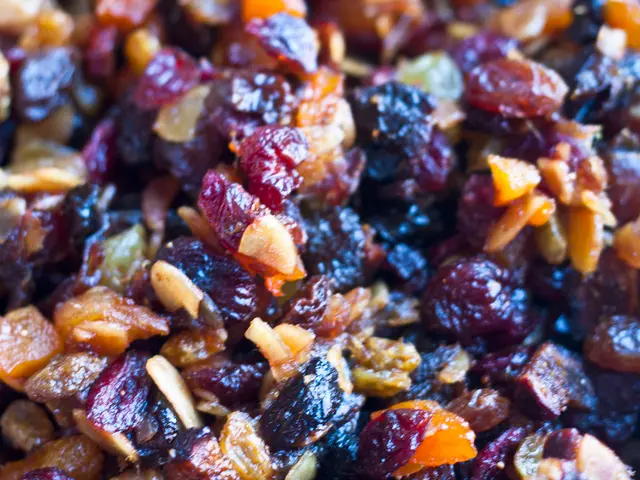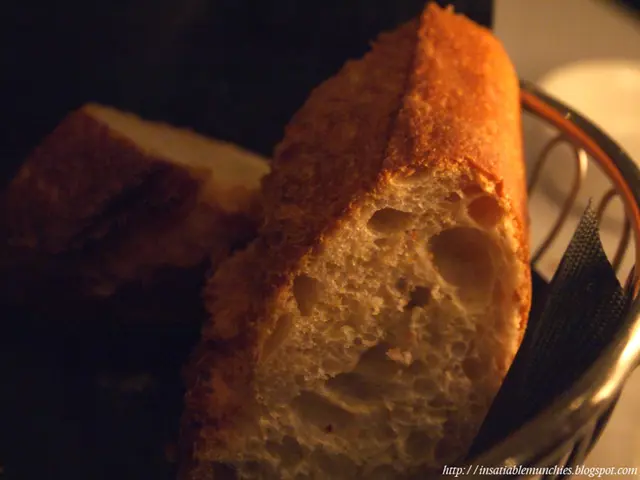Simple Guide to Homemade Sourdough Bread
Rewritten Article:
Are you a pandemic bread-baking novice or just a little rusty on your sourdough skills? No worries! Grab some flour, a kitchen scale, and your kitchen scissors, and let's dive into the art of homemade bread baking.
That's the goal of "Roly's Bread Baking Bible" - a comprehensive guide to bread making for both beginners and experienced bakers. Roly Allen, a seasoned baker, shares his expert tips and tricks, from the basics of grain anatomy to techniques for maintaining a homemade sourdough starter. He provides helpful insights into important tools, such as kitchen scales and kitchen scissors, and offers step-by-step visuals demonstrating his kneading and folding methods to ensure you always know what you're doing.
Along with classic sourdough recipes, Roly encourages experimentation, offering suggestions for mouth-watering creations like poppy seed rolls, walnut rye bread, and chocolate-stuffed sourdough. But if you're simply focused on perfecting your sourdough game, try out Roly's signature overnight recipe below. This recipe allows for a long rise, with only 10 hours of fermentation, followed by baking in a casserole or Dutch oven. For those who desire a more effortless approach, Roly includes techniques for no-knead variety bread, making bread-baking accessible for all.

Once you master your first loaf, don't forget to post it online! This will automatically make you a member of the pandemic's most talked-about baking community. Welcome aboard!
Excerpted from "Roly's Bread Baking Bible" by Roly Allen (c) 2020 by Roly Allen. Reprinted by permission of Laurence King Publishing Ltd. All rights reserved.
Techniques: Kneading

Most of the recipes in this book use a simple pull-fold-and-rotate action. However, some recipes require kneading. Here's a basic method you should follow:
Kneading might be synonymous with bread making, but it doesn't have to be a complex process. The essential steps are stretching, folding, and turning. By repeating these actions, you'll organize the gluten molecules in your dough, transforming it from a sticky mess into a smooth ball.
To begin, dust your work surface lightly with flour to prevent sticking. Transfer the dough from the bowl onto the surface.

Pull apart the ball with your fingertips, stretch it outward, and fold it back in on itself. Rotate through 90 degrees (a quarter-turn) and repeat this process until the dough becomes smoother and more elastic. The recipe will indicate if you need to knead for a specific period. Once you've completed the kneading, gather the ball together using a dough scraper to prepare it for transfer into your banneton or proving basket.
Overnight Sourdough Recipe
For home bakers using a casserole (or Dutch oven), the baking process is simple yet delicious. The following recipe is designed with minimal work and minimal washing up in mind.

Overnight Sourdough
Serves: 1 Loaf
INGREDIENTS

- 50g active Sourdough starter
- 400ml warm water
- 600g strong white bread flour
- 10g (2 tsp) fine salt
INSTRUCTIONS
- Mix the sourdough starter and warm water in a large mixing bowl. Gradually add the flour, stirring until the mixture is evenly combined.
- Cover the bowl with a clean tea towel and let the dough rest for 30 minutes.
- Work the salt into the dough, incorporating it slowly to ensure an even distribution.
- Perform a series of stretch-and-folds eight to ten times to form a tight, round loaf. Cover the bowl with cling film or a damp tea towel and allow the dough to rise for about 8-10 hours, or overnight, at room temperature. The dough should become soft and puffy during this time.
- About an hour before baking, lightly flour your work surface, then tip the dough out onto it. Let it rest for over an hour, before shaping it into a round loaf. Transfer the ball of dough to a floured proving basket or linen and let it rest for another hour.
- Preheat your oven to 230°C (450°F) with a Dutch oven or casserole dish. Cut a piece of parchment paper about 35-40cm square. When the oven is ready, carefully transfer the loaf onto the parchment paper, then place it inside the preheated Dutch oven (or casserole). Make a couple of shallow cuts into the top of the dough using a pair of kitchen scissors. Cover the Dutch oven or casserole, and bake for 20 minutes.
- Remove the lid from the Dutch oven or casserole to allow the crust to brown. Bake for another 25 minutes, then remove the bread from the oven, tap the base, and confirm it's hollow. If not, bake for an additional 5-10 minutes. Allow the bread to cool on a wire rack, then slice and enjoy!

Related Video: Mastering the No-Knead Bread Technique with Store-Bought Yeast
Header image by Ida Riveros.
Enrichment Data:
Learning the craft of bread making, particularly sourdough, can be both tasty and gratifying. Newcomers will find useful insights and techniques to start their sourdough journey:
Understanding Sourdough Basics
- Sourdough Starter: Initiate your journey by cultivating a sourdough starter, which is a naturally occurring mix of wild yeast and bacteria that ferments the sugars in your dough, leading to the characteristic sourdough flavor and rise. Active sourdough starters require regular feeding.
- Environment: Keep your starter and dough at a warm, draught-free place, typically around 75°F to 80°F (24°C to 27°C), to facilitate fermentation.
- Mastering the pull-fold-and-rotate action in baking could make your homemade bread-making process smoother.
- Roly's Overnight Sourdough recipe requires minimal effort, making it an ideal choice for those seeking quick bread-making techniques.
- A well-kneaded dough, with its organized gluten molecules, transforms from a sticky mess into a smooth ball - a key technique to remember when baking bread.
- Sharing your homemade bread success online can make you a part of the pandemic's most talked-about baking community, connecting you with fellow bread enthusiasts.







